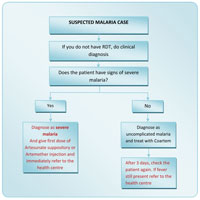8.1.2 Treatment of uncomplicated malaria based on clinical diagnosis
If you do not have the RDT in your Health Post, then use clinical methods (as described in Study Session 7) to diagnose suspected malaria in people seeking your help. If the diagnosis is clinical rather than parasite-based, treat uncomplicated malaria cases as follows:
- If the person does not have signs of severe malaria, then treat the patient with Coartem. After three days, check the patient again. If fever is still present refer the patient to the health centre.
- If the person has signs of severe malaria (as described in Section 8.2) then diagnose him/her as having severe malaria. Give first dose of Artesunate suppository or Artemether injection and immediately refer the patient to the nearest health centre.
- Advise the patient/caregiver to come back if the patient does not show any improvement after three days of treatment with anti-malaria drugs, or if the signs and symptoms get worse at any time.
Whenever you encounter a suspected malaria case and you do not have RDTs, Figure 8.4 will guide you in the details of the procedures and steps that you need to follow for the treatment and referral of patients diagnosed clinically.
8.1.1 Treatment of uncomplicated malaria based on RDT confirmation

